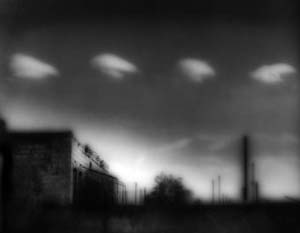
|
BEYOND THE BLUE
 Lift up your eyes and look into the distance. What do you see? What do you see when you gaze
at the furthest point that the eye can see - when you look at distance itself?
The color blue.
Lift up your eyes and look into the distance. What do you see? What do you see when you gaze
at the furthest point that the eye can see - when you look at distance itself?
The color blue.
Miles and miles of endless blue. In hebrew, there is a specific name for that color. It is called "techeilet." When everything is clear and nothing hinders our view, when we gaze into the sky as far as the eye can see, to the end of sight itself, we see techeilet. Techeilet is the color of beyond. A Jew wears a four-cornered garment with four threads attached to its extremities. These threads are called "tzitzit." The root of the word tzitzit is connected to the word meaning "to peek," l'hatzitz. Three of the threads of the tzitzit are white; the fourth is supposed to be the color of techeilet. (Today, we have lost the undisputed identity of the fish from which the techeilet dye was made, and so most people only wear white. However, the original form of the commandment was that one of the four threads should be techeilet.) The mitzva of tzitzit is a mitzva of sight. The Torah tells us that we should see the tzitzit. What are we supposed to see when we look at these threads of wool? The four-cornered garment represents the physical boundaries of this world, the limits within which we are constrained. We speak of the "four corners of the world." These are the boundaries that enclose us. Although we are confined within this world of limitation, this four-cornered world, the Creator has commanded us to place on its corners a thread of blue, and by doing so we can connect this entire enclosed system to that which is beyond; we can "peek" into the infinite. The techeilet blue of the tzitzit is a reflection of the blue of the sea, and the blue of the sea is a reflection of the blue of the heavens. The sea is our first step in connecting to that which is without end. The sea is boundless. Left to itself, the sea would drown the world. What stops the sea from doing so? "I have placed the sand as a boundary to the sea" (Yirmeyahu 5:22). The Creator has placed a border to the sea. he has limited its domain. Left to itself, however, the sea itself is unlimited. Every wave expresses the desire of the sea to swamp the land and expand without limit. The next step is to the sky. Techeilet is a reflection of the heavens, the blue beyond. The heavens are a reflection of the Kisei HaKavod. The Kisei HaKavod is a mystical concept. It is "God's Throne." It is the connection to the ultimate existence that has no end - the will of God. Techeilet is the color of that which is boundless. If we had not lost the identity of that blue dye, if that color had not been taken away from us, we would carry with us a thread that connects us to the heavens, to a grasp of the Ein Sof, literally, "that which is without end." There's a connection between the word techeilet and another word in hebrew that is spelled almost identically. That word is tachlit, which means "end" and "purpose." The blue of the techeilet allows us a glimpse of our ultimate end and purpose. In hebrew, the word for "heavens" is shamayim. Shamayim comes from the root meaning "there" - sham. The heavens represent all the "theres" that are possible. All the "sham-im" that can be. When we look to "there" - into the endless distance - we see techeilet, the end and target of all; the place of all "there" - Shamayim, Sham-im - the blue heavens. Only one of the strands of the tzitzit, however, is blue. The other three are all white. What is the significance of the color white and how can we understand the presence of both the blue and the white together? If the end of all sight is the color blue, the beginning of all sight is white. Take the three primary colors - red, green, and blue - and paint them on a wheel. Spin the wheel and what will you see? White. White is the root of all color, the background to all color. White is the place where color begins - where seeing begins. On the holy days of Rosh haShana and Yom Kippur, there is a widespread custom to dress in white. Among other reasons, this is a remembrance of the vestments of the kohen gadol, who ministered in white on Yom Kippur. Yom Kippur is the day when all the "contracts" of our liabilities are erased. It is the day when we are given a clean sheet - a pure white page on which to write in the coming year all our thoughts and actions. The kohen gadol serves in white garments; everything goes back to white. The Creator tells us that when we return to him "if your sins will be as scarlet, as snow I will whiten them." White is the source, the beginning of all sight. Techeilet is the end, the purpose of all sight. When we have an unobstructed view of the world, when we see from white to techeilet, we see the world and its purpose from beginning to end. THE BLUE BEYOND
somewhere,an endless summer afternoon wind caresses wheat, row upon row whisper to each other the confiding hush of high summer sometimes, when i close my eyes i can see beyond the blue, to the blue beyond More articles available at Ohr Somayach's website. |